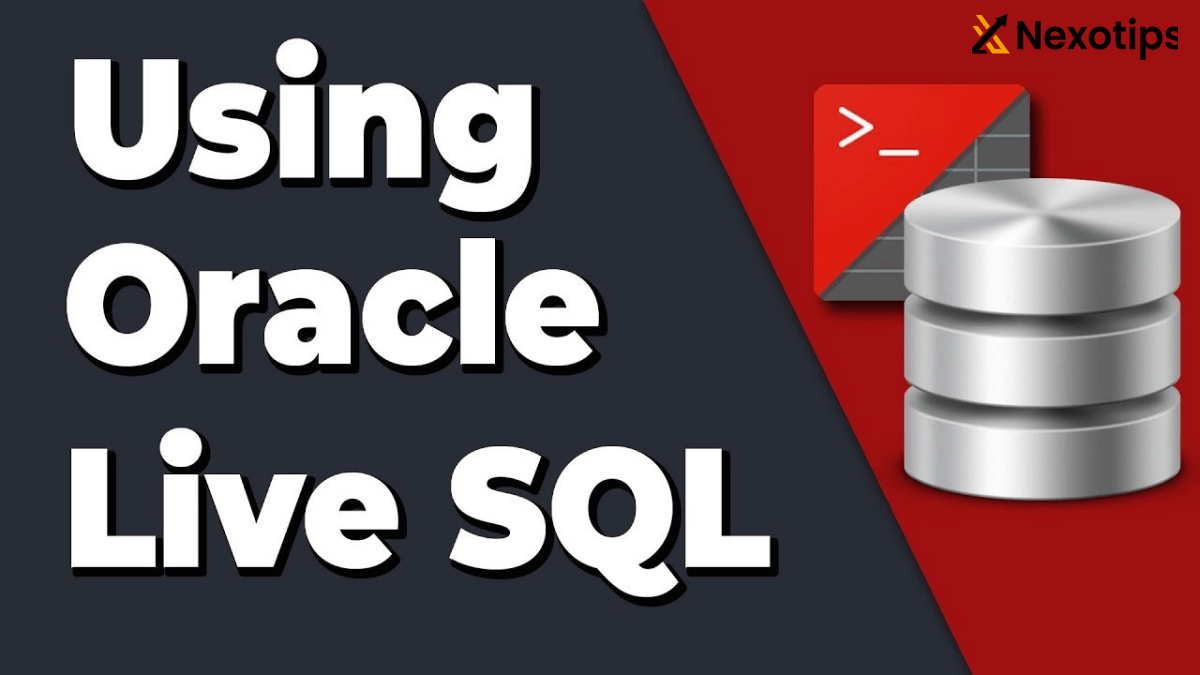
The Power of Oracle Live SQL 2024 : A Comprehensive Guide
In the realm of SQL development and database management, Oracle Live SQL emerges as a game-changer, offering users a convenient, web-based platform to write, run, and test SQL statements effortlessly. This comprehensive guide aims to delve into the depths of Oracle Live SQL, exploring features of Oracle Live SQL , functionalities, and benefits for both novice learners and seasoned professionals in the field. The Power of Oracle Live SQL : A Comprehensive Guide is an online SQL supervisor with a Oracle data set worked in. It’s kept up with by Prophet and permits you to compose and run SQL proclamations effectively without setting up your own Oracle data set.
Contents :
What Is Oracle Live SQL?
Oracle Live SQL is an online SQL manager with a Oracle data set worked in. It’s kept up with by Oracle and permits you to compose and run SQL proclamations effectively without setting up your own Oracle data set.
Oracle Live SQL runs Oracle data set variant 19c Undertaking Release – 19.14.0.0.0.
How to Access
You can access Oracle Live SQL by going to the livesql.oracle.com.
The fundamental element of this page is to permit you to look or peruse for an instructional exercises. We’ll cover this later in the aide, yet Prophet Live SQL incorporates a scope of instructional exercises to assist you with learning explicit elements of Prophet, where you can understand directions and run the Oracle Live SQL squarely in the program.

You can likewise get to a SQL manager by clicking Begin Coding Now.
You’ll be taken to the login screen on the off chance that you click Begin Coding Now. You can likewise get to this by tapping the Sign In button on the upper right of the principal screen.
Create an Account
To create an account, enter all of the mandatory fields and click Create Account.
As I would see it, there are unreasonably many fields on this necessary screen to make a record, and extremely a large number of them are required.
For instance, for what reason does Prophet have to realize my organization name and my location to make a record?
At any rate, whenever you’ve finished up this page, click Make Record and you will have another Prophet account.
Overview of the User Interface
Once you’ve signed in, this is the main Oracle Live SQL screen you’ll see this.
Sidebar:
On the left, you’ll see a sidebar that incorporates a couple of menu things like Home, My Meeting, and Mapping. We’ll cover these choices later in this aide. On the off chance that you don’t see this sidebar, you can tap on the burger menu to show and conceal it.
SQL Worksheet:
the top piece of the fundamental region of the screen is the SQL Worksheet. You can compose and run SQL proclamations here.

Yield:
the result of your SQL explanations is displayed at the lower part of the screen. This can be resized all over to set aside more space for the SQL or more space for the result.
Buttons:
on the upper right of the screen you can see a couple of buttons :
- Clear : clear the SQL in the worksheet
- Find: track down a string in your SQL worksheet
- Activities : view meeting subtleties, reset your meeting, or set the greatest lines inclination.
- Save : save your SQL worksheet
- Run : run the content
Footer:
on the lower part of the screen, you can see some data about the apparatus: what variant of Prophet Live SQL is distributed, what Prophet information base adaptation it utilizations, and a connections to documentation and different devices.
Running SQL Statement
To run a SQL explanation in Oracle Live SQL, you type it into the SQL Worksheet and either click the green Run button in the upper right or press Order + Enter (on Macintosh) or Ctrl + Enter (on Windows).
We should make a table. Here is the SQL to make it happen.
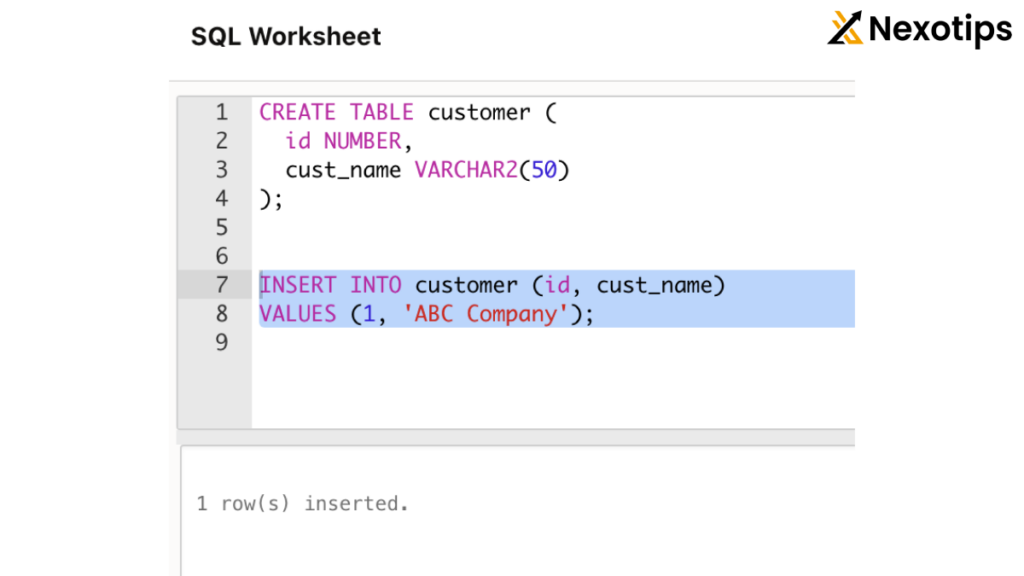
CREATE TABLE client (
id NUMBER,
cust_name VARCHAR2(50)
);
At the point when we run the content, we can see a “Table Made” message.
Export Results as CSV
You can export the results of a SELECT query to a CSV file by clicking the “Download CSV” link that appears at the bottom of the results table.
Save SQL as Content
To save the SQL you have composed, you can do this in Prophet Live SQL. Click on the Save button on the upper right of the screen. Enter a name for your script.
Set the visibility:
- Private: only you can see this
- Publicly Shareable: a URL is generated and you can share the script using this IRL
- Published: the URL for the script is included in the Live SQL Code Library

Select Private for now. enter a description for your script. In the Area drop-down, you can select which category this script belongs to, which can be helpful for organising your scripts if you have a lot of them. You can also enter some tags to help categorise your script.
Click “Save Session as Script” when you are done. Your script is then saved.
On the page that loads, you can see:
- the details you entered about the script (name, description, area, tags, visibility)
- when it was last updated
- each statement in the script and its output.
Exploring the SQL Worksheet
- Composing SQL Proclamations
- Executing Inquiries
- Working with Information Definition Language (DDL)
- Active Models and Instructional exercises
Maximizing Productivity with Advanced Features
- Leveraging the Sidebar Menu
- Customizing Preferences and Settings
- Utilizing Keyboard Shortcuts
- Integrating External Tools and Resources
Enhancing SQL Development and Testing
- Table Creation and Modification
- Query Optimization and Performance Tuning
- Transaction Management
- Error Handling and Debugging Techniques
Collaborative Learning and Knowledge Sharing
- Community Engagement and Forums
- Sharing SQL Scripts and Code Snippets
- Participating in Challenges and Competitions
- Networking with Peers and Experts
Advanced Topics and Best Practices
- Data Security and Access Control
- Backup and Recovery Strategies
- Database Migration and Integration
- Scalability and High Availability Considerations
Real-world Applications and Case Studies
- Industry-specific Use Cases
- Success Stories and Testimonials
- Tips for Implementing Oracle Live SQL in Production Environment
- Future Trends and Innovations
Tips and Tricks for Optimal Usage
- Performance Optimization Techniques
- Troubleshooting Common Issues
- Maximizing Efficiency with Time-saving Strategies
- Continuous Learning and Skill Development Resources
Explore the Database Schema
So you’ve created some objects. How can you see them? You can view the objects in your schema by clicking the Schema item on the sidebar.
Actions – Generate DDL
Click on Actions then Generate DDL, and a window will appear that shows the SQL that has been generated to create the objects in your database.
Here’s the script in this example:
CREATE TABLE "CUSTOMER"
( "ID" NUMBER,
"CUST_NAME" VARCHAR2(50) COLLATE "USING_NLS_COMP"
) DEFAULT COLLATION "USING_NLS_COMP"
CREATE OR REPLACE EDITIONABLE SYNONYM "DBMS_XPLAN"
FOR "LIVESQL"."ORACLE_SQL_USER_XPLAN"
CREATE OR REPLACE EDITIONABLE SYNONYM "V$SESSION"
FOR "LIVESQL"."ORACLE_SQL_USER_V$SESSION"
CREATE OR REPLACE EDITIONABLE SYNONYM "V$SQL_PLAN_STATISTICS_ALL"
FOR "LIVESQL"."ORACLE_SQL_USER_V$SQL_PLAN_S_A"
It’s different to the script that we ran, as this is generated from what is on the database.
Create Database Object
Click on the Create Database Object button, and you can create one of a range of object types on the database. You’ll see this window.
Here are the object types you can create:
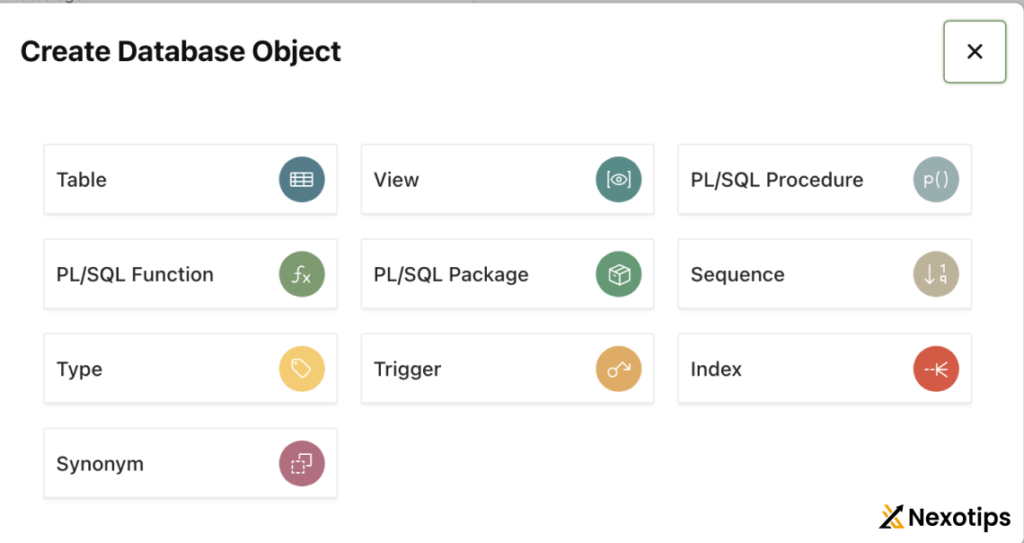
If you click on one of the options, you’ll see another screen where you can input the object name, parameters, and other options. The screen is different for each type of object.
Quick SQL
The Quick SQL include permits you to utilize an organized text to create an information model and SQL.
From the assistance segment:
Fast SQL gives a speedy method for producing the SQL expected to make a social information model from an indented text report. This instrument is intended to decrease the time and exertion expected to make SQL tables, triggers, and file structures. This instrument isn’t intended to be a substitution for information displaying, it is just a speedy method for fostering a content for basic tables and perspectives. When the SQL is produced it very well may be changed and developed.
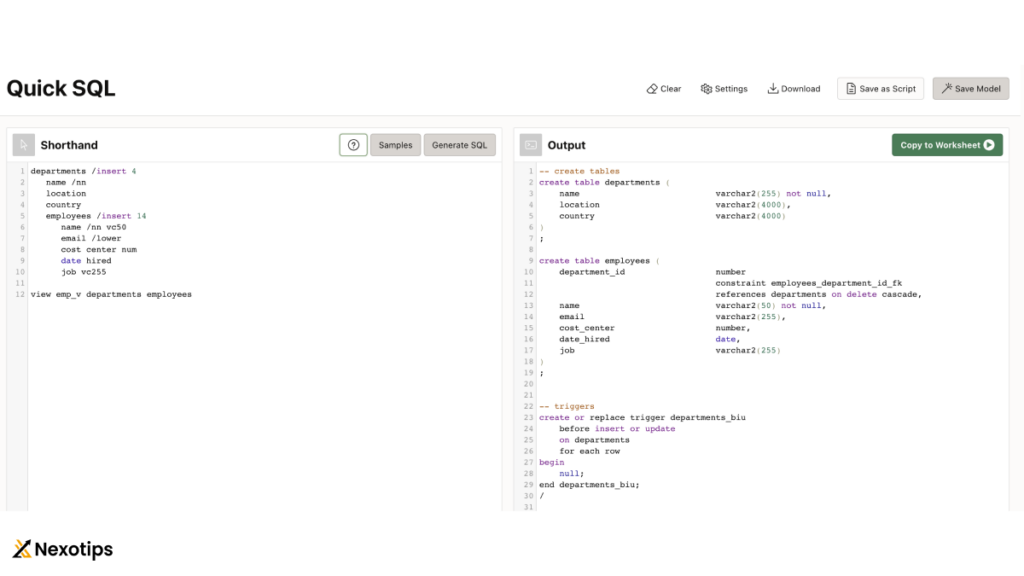
You can enter text in a shorthand configuration, which is very much depicted in the assistance guide. You can likewise stack an example to perceive how it functions.
My Scripts
This includes scripts you have saved in previous sessions as well as the current session, and any scripts you have uploaded using the Upload Script feature. The heart icon indicates the number of likes (scripts can be liked by others if they are visible), and the number of times the script has been run.
On this screen, you can:
- search for scripts
- sort by date added, date last touched, name, invocations, and statements
- filter by visibility and area
If you click on a script in the list, you can see more information about it.
My Tutorials
Oracle Live SQL lets you create tutorials. A tutorial is a collection of instructional steps and SQL that users can read and run within Oracle Live SQL. There is a range of tutorials already created, and accessible in the Code Library. But you can also create your own.
Create Tutorial
We don’t have any yet, so let’s click Add Tutorial. You can enter a range of details for this:
- The name of the tutorial
- The area that it belongs to
- The overview or description of the tutorial
- Any setup SQL that is needed
- Any tags that you want to apply
- The user display name
Run Tutorial
To run a tutorial, open the tutorial and click on the Run button. The SQL Worksheet screen will be opened, with the tutorial displayed in a panel on the right.
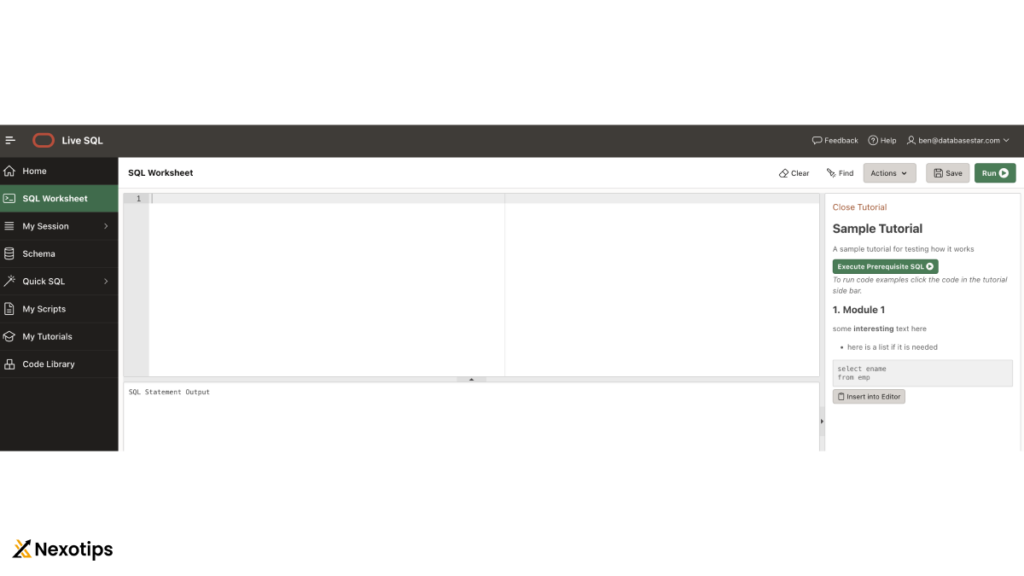
This will let you:
- execute the prerequisite SQL that you had defined in the tutorial
- see the text within each module
- copy any code (which was formatted in code tags) to the editor for you to run.
This makes it easy for others to follow along with your script.
Every now and again Clarified some things
How Might I Change the Most extreme Number of Columns to Show?
On the SQL Worksheet, click on Activities, then, at that point, Most extreme Lines Inclination. Change the worth of Most extreme Lines to Question to one more worth in the rundown. The greatest is 5,000.
Could Prophet at any point Live SQL Import CSV Information?
Sadly, right now Prophet Live SQL doesn’t can import a CSV record.
An option is convert it to a progression of SQL Supplement proclamations (in a calculation sheet, for instance) and transfer the SQL script.
How Might I Show Tables in Prophet Live SQL?
You can see every one of your tables in the Pattern segment. You can likewise choose from the user_tables view to see a rundown.
SELECT *
FROM user_tables;
This will show all the tables in your mapping.
Could I at any point Load the HR Data set in Prophet Live SQL?
Indeed, there is a content in Prophet Live SQL for the making these tables. You can think that it is here, or quest for “HR” inside the Code Library.
Could I at any point Show Line Numbers for Troubleshooting?
There is no setting to empower this, yet you can follow the means in this content to assist with the troubleshooting and seeing a stack follow.
conclusion :
Oracle Live SQL stands as a dynamic and indispensable tool for the SQL developers, offering a seamless and intuitive platform for the honing skills, testing queries, and collaborating with peers. By harnessing the power of the Oracle Live SQL, users can unlock new possibilities in the database management and propel their careers to a new heights.
This comprehensive guide serves as a roadmap for the navigating Oracle Live SQL’s features, functionalities, and best practices, empowering users to an unleash the full potential of the SQL development in the digital era. Oracle Live SQL is a helpful web-based tool and a great way to get started working with an Oracle database or practicing SQL online.
